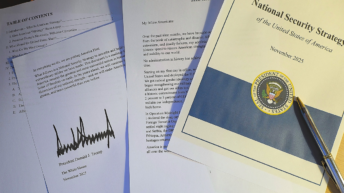
The ceasefire announced by US President Donald Trump with characteristic aplomb at around 5.30 p.m. IST on May 10, 2025, stunned India. Trump tweeted, “After a long night of talks mediated by the United States, I am pleased to announce that India and Pakistan have agreed to a FULL AND IMMEDIATE CEASEFIRE. Congratulations to both Countries on using Common Sense and Great Intelligence…”
US Secretary of State Marco Rubio followed with a long post at 5.46 p.m., “Over the past 48 hours, @VP Vance and I have engaged with senior Indian and Pakistani officials, including Prime Ministers Narendra Modi and Shehbaz Sharif, External Affairs Minister Subrahmanyam Jaishankar, Chief of Army Staff Asim Munir, and National Security Advisors Ajit Doval and Asim Malik. I am pleased to announce the Governments of India and Pakistan have agreed to an immediate ceasefire and to start talks on a broad set of issues at a neutral site. We commend Prime Ministers Modi and Sharif on their wisdom, prudence, and statesmanship in choosing the path of peace.”
Thereafter, Foreign Secretary Vikram Misri announced at 6:01 p.m. that Pakistan’s Director General of Military Operations (DGMO) called the Indian DGMO at 15:35 hours (3.35 p.m.) on the afternoon of May 10, 2025, after which both sides agreed to “stop all firing and military action on land and in the air and sea with effect from 1700 hours Indian Standard Time.” Misri said the DGMOs would talk again on May 12, 2025.
We need not dwell on the shock with which news of the ceasefire was received by the Indian public as Islamabad eviscerated it within three hours. Pakistan reportedly sought Washington’s help when India struck critical military facilities deep inside its territory, but the pause was swiftly nixed by hotheads within its own ranks. New Delhi responded to each act of aggression, and is free to resume action after appraising the situation following the DGMO meeting.
In an interview with Pgurus (here), Maj Gen Rajiv Narayanan (retd) said the precision strikes at Sargodha, Jacobabad, Kirana, and at the Chagai nuclear testing site in Balochistan, where the largest number of N-warheads are stored, caused tremours of 4.4 in Sargodha and 5.7 in Chagai on the Richter scale). These readings were picked up by sensors all over the world.
The explosions allegedly damaged the fissile material (below critical mass) and caused radiation leakage though that has been denied by the IAEA. According to Narayanan, warheads stored in Chagai and Kirana Hills were rendered useless because most of the tunnel entrances have been blocked by strikes from India’s BrahMos and Israeli Spike missiles. Now the sites cannot be used for at least one thousand years. Pakistan’s “nuclear sabre rattling is all over” he claimed..
This operation ended around 4 a.m. on May 10, and within an hour, a Nuclear Emergency Support aircraft (B350 AMS) of the US Department of Energy (N111SZ, Hex Code A03192) was circling the Chagai and Kirana Hills, assessing radiation levels. On May 12, 2025, an Egyptian plane (EGY1916) landed in Rawalpindi reportedly carrying an emergency shipment of Boron, used to dampen radioactive radiations. Yet, during the special defence briefing on May 12, 2025, India’s DG Air Operations, A.K. Bharti, said, “We have not hit Kirana Hills.”
However, an Austrian analyst and one of the world’s leading combat aviation historians, was brutally frank. Dubbing India’s air campaign a clear-cut victory, he said, “When one side is bombing nuclear weapons storage facilities of the other, and the other has no ability to retaliate left, then that’s a clear-cut victory in my books. No surprise Islamabad ‘sounded’ for a ‘ceasefire.’”
After the US urged restraint, India decided to modify its rules of engagement with Pakistan, whereby any future act of terror will be formally considered as an Act of War, attracting a commensurate response. MEA sources clarified that the suspension of the Indus water treaty is not affected by the temporary ceasefire.
By the time of the so-called ceasefire (6:45 p.m., May 10, 2025), India had bombed eleven Pakistan Air Bases (Nur Khan, Rafiqui, Murid, Sukkur, Sialkot, Pasrur, Chunian, Sargodha, Skardu, Bholari and Jacobabad). Col. Sofiya Qureshi debunked Pakistan’s claim to have damaged India’s S-400 and BrahMos missile base with its JG-17 fighter aircraft. She refuted claims that Indian airfields in Sirsa, Jammu, Pathankot, Bhatinda, Nalia and Bhuj, and ammunition depots in Chandigarh and Vyas were damaged.
India’s S-400 Triumph air defence system carried the day. Stiffly opposed by Washington, New Delhi signed the $5.4 billion deal with Russia in 2018 and received deliveries in 2021. The indigenous Akash SAM system performed admirably, as did other indigenous platforms.
In a major scoop, India recovered a PL-15 BVR missile almost intact, which will be sent to the DRDO for analysis. The findings could give the IAF a huge advantage in the future. The IAF’s Su-30 jet successfully dodged more than eight HQ-9BE SAMs and PL-15 BVR missiles.
The big surprise of the conflict was the fact that the 300 to 400 drones used to infiltrate 36 locations were Turkish Asisguard Songar drones (Col. Sofiya Qureshi, May 09, 2025). The drones were launched on the night of May 08-09, 2025, from Leh to Sir Creek. One attempted to hit Bhatinda, but was neutralised. India responded by launching armed drones at four Pakistani air defence sites, and destroyed one. Analyst Nitin Pai observed that this was “an intrusion of a West Asian player into the subcontinent’s politics,” which New Delhi will have to manage by confronting Ankara diplomatically and economically and deepening ties with Armenia, Greece and Russia.
India was temporarily released from the burden of an unpopular ceasefire when Pakistan sent drones into Jammu and Kashmir, targetting Udhampur, Akhnoor, Nowshera, Poonch, Rajouri, Mendhar, Jammu, Sunderbani, RS Pura, Arnia, Kathua) soon after the pause (8:34 p.m., May 10, 2025). It included Punjab, Gujarat and Rajasthan in its crosshairs.
Though India has the upper hand so far, the victory did not come cheap. Civilian areas, including a school (Poonch), gurdwaras and temples, were targeted. Attempts to hit the Golden Temple in Amritsar were foiled. The Aap Shambu Temple in Jammu also had a narrow escape. The final toll of casualties is yet to be collated, but soldiers and civilians (including two school children) have been martyred in border regions, and several injured. The addl. Deputy commissioner, Rajouri, was killed by Pakistani shelling.
After the all-party meeting in New Delhi on May 08, 2025, AIMIM chief Asaduddin Owaisi said that he had suggested that India “run a global campaign against the Resistance Front (TRF)” and urge the US Government to “designate it (TRF) as a terrorist organisation. We should also make efforts to grey-list Pakistan in the FATF…”
India’s High Commissioner to the United Kingdom, Vikram Doraiswami, exposed the close nexus between the terrorists killed in Operation Sindoor and the Pakistani State on Sky News, showing a picture of the funeral of LeT terrorist Abdul Rauf with uniformed officers standing behind US-designated terrorist Hafiz Abdul Rauf (May 09, 2025). The Pakistani officials present included Lt Gen Fayyaz Hussain, Maj Gen Rao Imran and Brig Mohd Furqan (from the military), Dr Usman Anwar (from the administration), and Pakistan’s Punjab legislator Malik Sohaib Ahmed. The presence of the Pakistani flag on the coffins proves that the terrorists are an integrated part of the military establishment.






Add comment